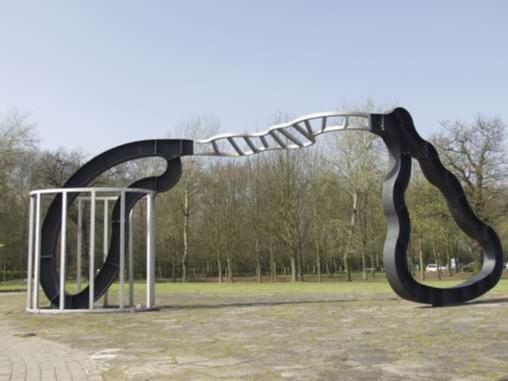Let's Not Be Stupid by Richard Deacon
 |
|
Let us know your thoughts about this sculpture on twitter @warwickuniart
In June 1987 an exhibition of Richard Deacon’s sculptures was displayed at the Mead Gallery. Five months later, he won the Turner Prize awarded by the Tate Gallery in London. The Turner Prize was established in 1984 to celebrate new developments in contemporary art. It is awarded each year to “a British artist under fifty for an outstanding exhibition or other presentation of their work in the preceding twelve months”. The first three years of the Turner Prize had been sponsored by Oliver Prenn, a member of the Tate’s Patrons of New Art who donated funds for new acquisitions.
Oliver Prenn is also a patron of musicians and orchestras, including the City of Birmingham Symphony Orchestra. He visited the University of Warwick in October 1985 to hear Simon Rattle lead the CBSO in recording all the works of Sibelius in the Butterworth Hall. And here, his two interests, art and music collided and he proposed the commission of a major work by Richard Deacon for the campus.
The commission took five years to complete and was Deacon's first commission for a large-scale, outdoor, permanent work. The artist originally chose the site of a big crazy-paving plinth that had been the home of the “Air Hall”: a large inflatable which acted as a Students Union between 1970-75 until the current building was completed. A new road scheme lead to the relocation of the sculpture to its current site in 2015.
The sculpture works as a huge drawing in space. Walking around it, the different shapes appear to contract and expand, changing from single black lines to rippling and smooth vessel shapes, defined by the black line. Everywhere you look, the sculpture frames sections of immeasurable space. The two forms appear to be in balance – it is ambiguous whether the larger form is pushing or pulling the smaller caged form and this adds to the sense of movement in this sculpture as does the twisting ladder form that connects them. The titles of Richard Deacon’s sculptures avoid constructing a single narrative meaning for the viewer: For those who have eyes (1983), Let’s not be stupid (1991), No stone unturned (1999), Water under the bridge (2008). They underscore the human condition and the constant choices that face us.
Richard Deacon describes himself as a ‘fabricator’, emphasising the construction behind the finished object. The design and making of this work are integral to its final form: the pockets of steel give it strength and the bolts that hold it together are unhidden. This honesty strips away non-essentials to make the play between material and meaning transparent. This work is the continuation of a long discourse by the artist about the relationship between freedom and constraint.
Slideshow:
